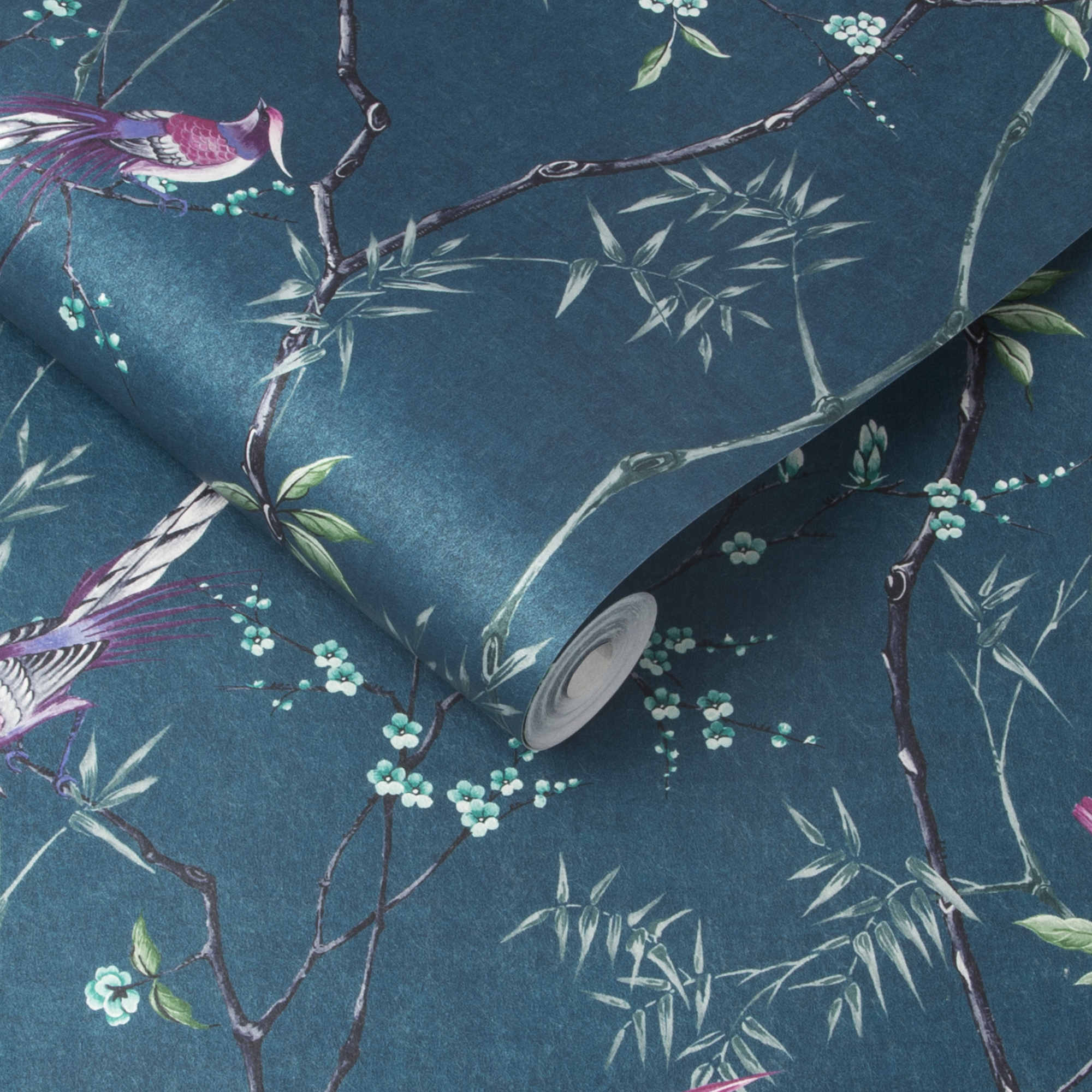Removing wallpaper: how to with a steamer, chemical stripper or soap solution
Strip out the old stuff easily with a steamer, chemical stripper or soap and water solution (if you're lucky). Removing wallpaper is a big part of giving your space a makeover...


Whether you've inherited a questionable floral wallpaper print, have grown tired of an outdated design or are wondering how to wallpaper walls from scratch for a pro finish, removing wallpaper is something that can and should be done with ease, and with no damage to your walls either.
While it can be tempting to paint or paper over existing wallpaper, this won't achieve as smart a finish as you might imagine. So, depending on what wall covering you're working with, you'll need to either remove wallpaper with a steamer, chemical stripper, or if you're lucky enough, soap and water...
We spoke with the experts at B&Q about the best ways to go about removing wallpaper:
'There are two methods when removing wallpaper:
It's all in the prep and method, 'Before you remove your wallpaper ensure the room is clear as much as possible, electricity is off, sockets are covered and everything is off the walls and dust sheets are down.'
Our handy step-by-step instructions are designed to help you achieve a professional result. Start by gathering your tools. You will need:
- Dust sheets
- Painters tape
- Putty knife
- Safety goggles
- Rubber gloves
- Mask
- Wallpaper removal tool (depending on your project): wallpaper stripper/steamer/soap and water/scoring tool/hair dryer
- Rags
Prepare your room
Before starting, you'll want to clear the room of any furniture, accessories or objects that you may get in the way or end up being damaged. Cover the floor with old sheets or dust sheets also.
Get small space home decor ideas, celeb inspiration, DIY tips and more, straight to your inbox!
- Find all the best wallpaper ideas to inspire a look you won't want to remove.
Switch off the mains
Cutting off the power is your next step so turn off the electricity, and also cover any light switches or electrical outlets with painter's tape. If you're unsure, consult an electrician.
Identify your wall type (and wallpaper)
You'll need to know whether you've plaster or drywall before you start removing wallpaper so as to pick the best method and not to damage the foundations in the process.
If this isn't wallpaper you've put up yourself, you might find many layers or crumbling plaster beneath it. And, if you have drywall you'll need to take care with using too much water as it's porous and prone to damage.
Start by gently peeling back a corner of the wallpaper, you can use a putty knife, to see what you're dealing with.
- Strippable/paste the wall wallpaper: If the wallpaper pulls away easily then it's likely you have strippable wallpaper which is really easy to remove. B&Q say 'Paste the wall wallpapers are as EASY to remove as they are to apply, simply peel back the wallpaper from the corner of a strip and pull upwards to remove it in one large piece!'
- Peelable/paste the paper wallpaper: If it leaves a paper backing on the wall, then it's peelable and this is also fairly easy to remove using soap and water as per our methods below.
- Traditional wallpaper: If it's a non-mover then you'll likely have to use a chemical stripper which is no one's first choice, but of course, it can be done.
Try to figure out how many layers of wallpaper there are to remove while you're there.
- DIY: How to fix a hole in the wall be it drywall or plaster.
How to remove wallpaper with a soap solution
If you're removing strippable wallpaper then you will likely get away with using a warm water and mild soap solution. B&Q recommends this hand soaking method (below) especially for paste the paper wallpaper and this should also work if you're removing a single layer of wallpaper from a small area such as a feature wall. You will need:
- Bucket
- Soapy Water
- Clean Pasting or Paint Brush
- Scraper
- Dust Sheets
- Washing up liquid
- Cover the floor using dust sheets to protect the surface from any water damage. The sheets can become wet. Have bin liners on hand to regularly clean up removed pieces of paper.
- Turn off any electricity as you will be using water to soak the wallpaper to ease its removal. Don’t switch back on until you are sure all surfaces are dry.
- Fill a bucket with warm water and add a small amount of washing up liquid. Apply the soapy water to the wall using the paint brush. Starting from the bottom up will break the surface tension allowing it to penetrate the wallpaper.
- When the wall is thoroughly wet, leave the water to soak in – this will help soften the paste that was used to hang the wallpaper.
- Scoring the paper with the edge of your scraper or a knife will help the water penetrate the wallpaper but could damage the plaster underneath. Use caution. How many layers of wallpaper and how long the wallpaper has been on will also be a factor.
- Using a scraper or a putty/stripping knife begin to lift the paper at the easiest point – often the seams of from the bottom of the wall. Let the water do the work and keep clearing the paper you have removed as you go, so as not to make more work later.
- If the wallpaper has been subsequently painted it can be quite difficult for the water to sink in – you may need to soak several times or alternatively you could use a wallpaper steam stripper.
Top tip: Remove wallpaper quicker with a steamer using the method below.
Removing wallpaper with a steamer
B&Q recommends, 'For electric steam stripping, hold the steamer at bottom of a wallpaper length for 10 seconds then move up onto the wall whilst pulling off the damp paper below and loosen stubborn areas with a stripping knife. Working from the bottom is best as the steam rises, making it more efficient and allowing for bigger pieces of wallpaper to be removed by pulling them upwards.
- Follow the room preparation instructions above then fill your steam stripper with warm water and wait for it to heat up. When you can see your steam stripper releasing steam, you'll know it's ready.
- Starting at the bottom and working upwards, section by section, hold your steam plate against the wallpaper you're looking to remove for approximately 10 seconds, or until the wallpaper becomes damp. Be mindful not to use your steam stripper on one area for too long, as this can damage the plaster below.
- Gently pull off the damp wallpaper, using a stripping knife to tackle any stubborn sections. While it can be tempting to work quickly, taking time to ensure you don't dig your stripping knife into the wall is worth it for the eventual outcome.
- Continue this process, working section by section, being mindful to work from the bottom upwards.
- Often, steam strippers come with small attachments designed to help you tackle more difficult areas. Use these as you see necessary.
- B&Q adds 'Brush off any leftover wallpaper with a broom or with a stripping knife.'
- 'Rinse the wall with sponge and water and then leave to dry.'
- 'Once dry, the power can be turned back on.'
Generally, the same approach to removing wallpaper can be used when tackling woodchip, so we'd recommend using the instructions above in order to achieve your desired outcome. If you're unsure, just take a little more time to deal with the new material. Ensure floors are well protected and that you have old shoes and clothes on – stripped wallpaper is sticky, and woodchip in particular.
If you're removing a wallpaper border with a steamer from a papered wall (and intend on removing the base paper, too) do the following:
- As with regular wallpaper, steaming is most effective when you work from the bottom upwards. So, begin by steaming the bottom edge of your border, working at the increasingly loose edge with a striping knife.
- Once you've loosened the bottom section, work your steamer upwards, gently pulling away at the wallpaper border. It should be fairly easy to remove.
- Work section by section until you've removed the entirety of your wallpaper border.
Removing wallpaper with chemical stripper
Whichever chemical stripper you go for, pay special attention to the instructions and safety notices that it comes with as some will require diluting before use. B&Q recommends, 'For chemical stripping, spray your ready-to-use stripping solution onto the walls and wait for it to do its work. Use short sharp movements with a stripping knife and keep the knife as flat as possible.' Here's the full method to remove wallpaper with chemical stripper:
- Prepare your room as per the above instructions.
- Cover your papered walls in chemical stripping solution, before giving the solution some time to work its magic. Pay special attention to the instructions outlined by the manufacturer.
- Once it's loosened up, use a stripping knife to gently remove the wallpaper, being mindful not to cause any damage to the wall behind. While it can be tempting to work quickly, taking time to ensure you don't dig your stripping knife into the wall is worth it for the eventual outcome.
- Pay attention to areas where the chemical stripper is beginning to dry out and make sure to reapply, as necessary.
- Dispose of any removed wallpaper as quickly as possible – it has a tendency to stick to the sheets if you don't.
How to remove wallpaper borders
Wallpaper borders can be tricky to remove; particularly if they're old, have been stuck to the wall for a long time, or were attached using a questionable adhesive.
Generally, there are three options available when seeking to remove wallpaper borders: a hairdryer, chemical stripper or steamer. We talk you through each of the options, so you can finally say goodbye to an outdated wallpaper border...
Removing wallpaper borders with a hairdryer
- Tackling an edge first is the easiest way to ensure success when using a hairdryer to remove a wallpaper border. So, take a hairdryer on its highest setting and hold it over an edge for up to 30 seconds, this should be long enough to loosen the paper.
- Use a stripping knife to gently lift the wallpaper border away from the wall, keep working at it until you begin to feel resistance.
- At the point of resistance, take your hairdryer again and hold it against the wallpaper border for another 30 seconds, or so.
- Repeat the process of heating and prizing away the wallpaper border until everything has been removed.
- Remember, some wallpaper borders won't respond well to the hairdryer approach, so you may need to consider an alternative option. Whatever you do, don't force it.
Removing a wallpaper border with vinegar
If you're looking for a natural solution, and are removing a wallpaper border from paint, as opposed to paper, consider combining apple cider vinegar and water, in order to create your own DIY wallpaper remover. Alternatively, warm water alone may work, though this depends entirely on the materials you're dealing with.
Removing a wallpaper border with wallpaper stripper
If you're dealing with a slightly more heavy duty adhesive, you might consider combining liquid fabric conditioner with some water, or going all out with a chemical wallpaper stripper. Once you've decided what kind of wallpaper stripper you want to use, prepare it for use in a spray bottle and follow these simple steps:
- For ease, you may wish to start by perforating your wallpaper border. This can be achieved using a perforating tool, or by using a knife to create diagonal scores across the length of the border.
- Next, you'll want to saturate your wallpaper border with your chosen solution. More is more in this instance, so soak the paper as much as possible, then leave for at leat 15 minutes so the solution can work its magic.
- Use a stripping knife to gently lift your wallpaper border from the paint or paper below. If you hit any stubborn sections, apply more solution and begin the craping process, again.
- Repeat this process until you've removed all of the wallpaper border.
How to remove residue wallpaper glue
Once the main wallpaper removal process is over, you may find that you're left with the odd bit of wallpaper glue residue. You'll want to ensure it's completely removed before you can begin decorating.
Use a brush and stripping knife to remove any leftover bits of wallpaper, then create a solution by mixing warm water, washing up liquid and a little bicarbonate of soda. For particularly stubborn wallpaper glue, you may consider adding a little vinegar to the solution, too.
Dampen a sponge with your solution, then tackle your walls using gentle, circular motions. You should notice that the glue begins to lift. Take a dry cloth and attempt to rub the glue away, in most cases this should be relatively easy, though you may need to use a stripping knife on any areas that are proving particularly tricky.
Take time to be thorough, as even the smallest remnants of leftover glue can detract from the finish of your soon-to-be redecorated room.Leave your wall to dry and, once you're satisfied, turn the power back on. After some minor (or major) repairs to your plasterwork, it's time to get decorating.
How do you get stubborn wallpaper off?
As a general rule, steam strippers – which (as the name might suggest) use steam to penetrate wallpaper – are the best option when tackling large areas of wallpaper; old adhesive; woodchip wallpaper or wallpaper that's proving particularly stubborn, and can dramatically decrease the time required to remove wallpaper.
Emily first (temporarily) joined the Real Homes team while interning on her summer break from university. After graduating, she worked on several publications before joining Real Homes as Staff Writer full time in mid-2018. She left the brand in 2020 to pursue another career, but still loves a second-hand bargain and sourcing unique finds to make her rented flat reflect her personality.
